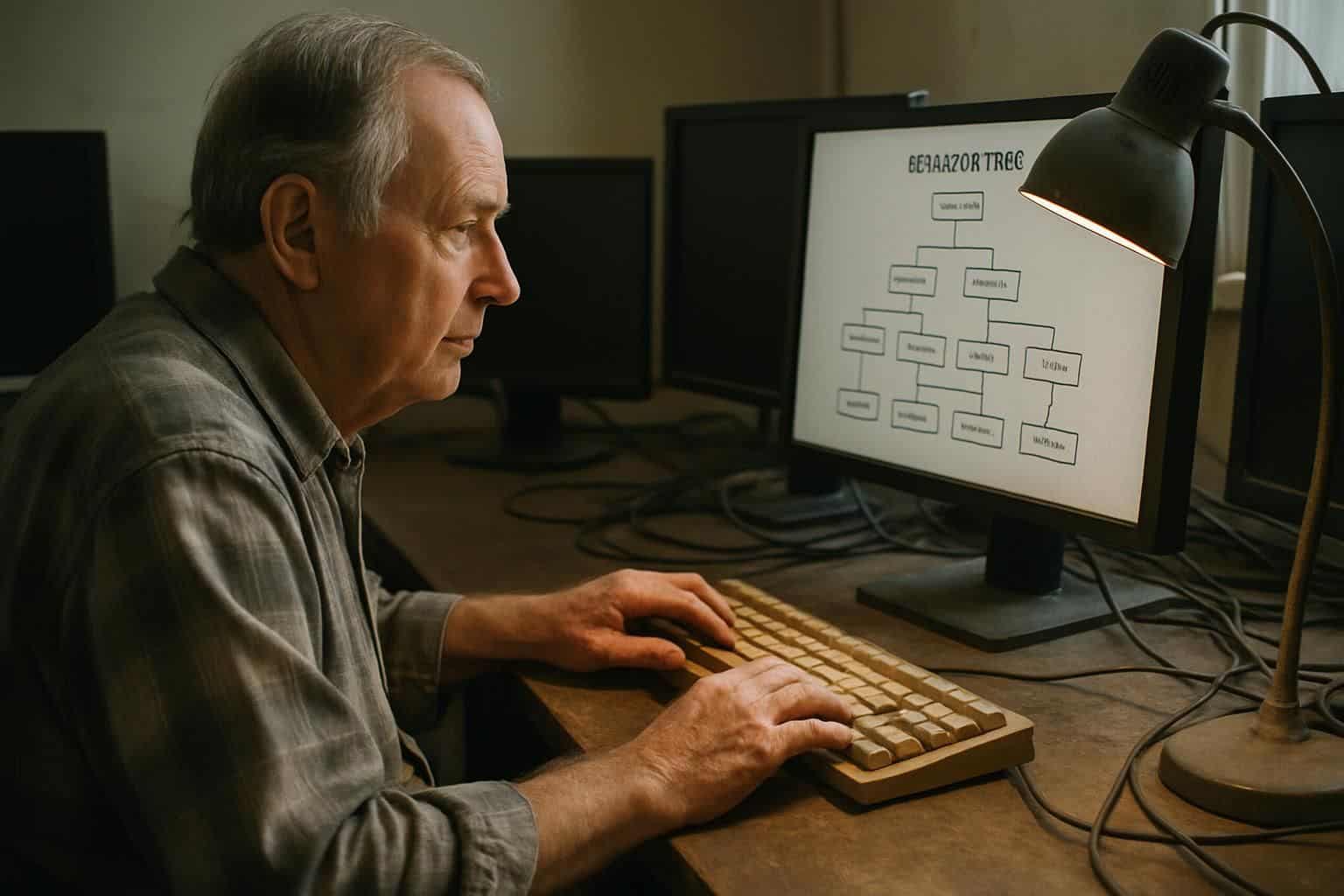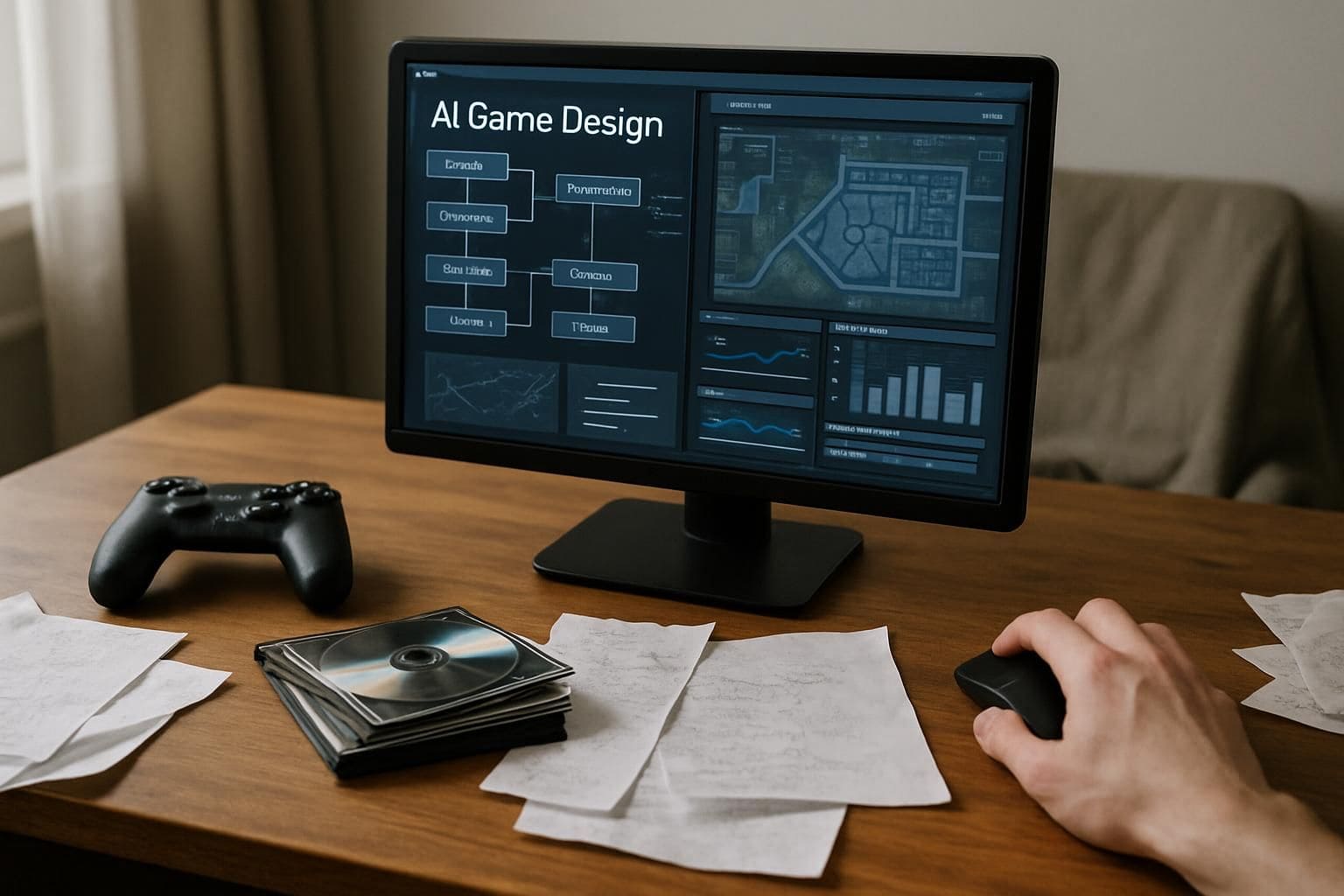Do you ever wonder, can AI make games that people actually enjoy playing? Google’s new AI “Genie” has studied about 30,000 hours of classic platformers like Super Mario Bros. and Sonic the Hedgehog to create playable games from simple image prompts.
In this post, you’ll discover seven critical ways artificial intelligence is changing gaming today, from procedural generation to smarter non-player characters (NPCs). Keep reading to see how AI might shape your future gameplay!
Key Takeaways
Google’s AI “Genie” studied 30,000 hours of classic platformers (like Mario and Sonic) to build playable games from simple image prompts.
Game developers use AI like neural networks, finite state machines, and reinforcement learning to create smarter NPCs that adapt in real-time; for example, DeepMind’s AlphaStar defeated expert human players in StarCraft II.
Procedural Content Generation uses algorithms trained with deep learning models to quickly generate varied game worlds—such as No Man’s Sky’s 18 quintillion unique planets released in 2016—and offers fresh experiences each time.
Challenges with AI include high computing costs which hurt smaller studios, as well as ethical issues about player privacy and data protection—especially when collecting details from younger gamers.
By 2025, experts expect AI tools will handle over half of all game production tasks—including designing worlds, developing adaptive stories based on player choices, automating art creation processes through platforms like Unity ML-Agents or Promethean AI.
Table of Contents
What is AI in Game Development?

Gaming, much like the betting industry with tools such as the Lucky 31 bet calculator, has always led in adopting advanced technologies like AI.
Artificial intelligence (AI) in gaming involves using computer-controlled agents and machine learning techniques that simulate human-like decision-making. AI allows game developers to craft intelligent non-playable characters (NPCs) who respond naturally and dynamically adjust difficulty levels based on player skills.
For example, platforms like AI Dungeon leverage generative pre-trained transformers (GPT models), trained on vast datasets, letting gamers enjoy games with personalized narrative arcs driven by conversational AI systems.
Through rapid concept art creation, realistic NPC speech generated by text-to-speech tech, and automated testing to identify bugs via millions of simulated playthroughs, artificial intelligence significantly lifts immersion and gameplay richness.
The strength of AI is its power to adapt; this makes games smarter and more fun.
Types of AI Used in Games

Game AI uses smart tools—like neural networks or finite state machines—to build lifelike actions and quick responses. From guiding players around obstacles to shaping how enemies act in stealth games, these systems improve player experience at each step.
Rule-Based AI

Rule-Based AI operates on clear, predetermined rules set by game developers. These rules decide how non-player characters (NPCs) behave in different game events and interactions. Finite State Machines (FSMs) often work with Rule-Based AI; they define NPC behaviors through distinct states and conditions that trigger changes from one state to another.
Behavior Trees also pair nicely with Rule-Based AI to map out complex decisions for realistic NPC behavior in games like “Watch Dogs: Legion” or stealth games.
This kind of artificial intelligence ensures characters act in a reliable way based on the game’s design parameters, making their choices logical and predictable every time a scenario repeats.
Combined with Pathfinding AI algorithms, it can guide NPC movement along ideal paths within virtual gaming worlds such as those created using Unity or Unreal Engine game engines. Overall player experience improves when games include well-built Rule-Based systems because they give consistent and engaging challenges suited to varied scenarios without repetitive outcomes.
Finite State Machines

Finite State Machines (FSMs) dictate NPC behavior through predefined states. They provide structured, predictable actions for non-player characters in video games and manage transitions based on clear, in-game cues.
FSMs help game developers build consistent player experiences by limiting random behaviors, keeping NPC interactions smooth and logical. Many classic video games use finite state machines; for instance, ghosts from Pac-Man alternate between chase and scatter modes using simple state rules.
Developers can combine FSM techniques with more advanced artificial intelligence methods like machine learning algorithms or reinforcement learning to create complex decision-making processes within NPCs.
For example, a zombie enemy in “The Last of Us” might shift predictably from idle to attack states once it detects the player’s location. By merging finite state machines with other AI tools such as pathfinding AI or large language models (LLMs), game creators generate lifelike animations and immersive interactions that enhance replayability.
Pathfinding AI

Unlike Finite State Machines that control NPC behavior states, Pathfinding AI guides NPC movement. Using smart algorithms like A* and Dijkstra, this artificial intelligence in gaming helps characters find the quickest routes through tricky game environments without crashing into walls or objects.
Algorithms must strike a balance between finding the very best path and keeping game performance smooth; too much complexity can slow everything down.
For example, games such as Minecraft use pathfinding to let villagers and mobs move around blocks easily. From first-hand experience playing detailed simulations like Skyrim, it’s clear effective Pathfinding AI boosts realism by making movements natural and believable.
This tech greatly improves immersion for geeks who love exploring vast virtual worlds filled with mazes or dense cities packed with obstacles.
Machine Learning AI

While Pathfinding AI helps NPCs move in games, Machine Learning AI makes gaming even smarter. This type of artificial intelligence uses training data from player actions to learn patterns and adapt.
For example, deep neural networks help create enemy AI that studies your moves and changes tactics fast. Game developers also use this tech for dynamic game difficulty balancing, making sure a game stays fun without becoming too simple or hard.
Machine learning algorithms boost player engagement through personalized experiences. They analyze emotional state and playing style while applying sentiment analysis to adjust the game’s challenge.
Real-time ray tracing tools powered by machine learning now deliver stunning graphics quality with realistic lighting effects; titles like Minecraft RTX show gamers how advanced visuals can enhance gameplay excitement.
On top of all these advances, automating bug detection has sped up testing steps during production; it’s one more reason why a game development career looks appealing today.
Behavior Trees

Behavior trees use a clear, hierarchical structure for decision-making in game AI. They let developers build behaviors through nodes that return three types of status: success, failure, or running.
Nodes come in three main kinds: Composite nodes handle multiple child actions; Decorator nodes alter results from one child task; Leaf nodes perform specific actions like moving characters or firing weapons.
Because leaf tasks are modular—allowing reuse—they speed up iterative game building and offer flexibility compared to Finite State Machines (FSM). Large multimodal models such as OpenAI’s GPT-2 provide methods to fine-tune behavior trees with natural language input, making virtual reality characters smart enough to engage naturally and respond quickly during gameplay.
Behavior trees simplify complex NPC interactions into manageable steps.
Reinforcement Learning
Reinforcement learning helps AI bots improve their actions through trial and error. Game developers use it to create intelligent NPCs (non-player characters). Google’s DeepMind showed this clearly when its AlphaStar beat skilled human players in the game StarCraft II.
This approach enables NPC behavior to grow smarter within complex gaming environments by adapting strategies over time, rather than following fixed paths. With reinforcement learning, enemies become more than simple targets; they can think carefully about tactics and respond dynamically during play.
How AI is Used to Create Games

Game makers now lean heavily on generative AI, deep learning, and automated testing tools to craft smarter games—curious how they pull it off?
Procedural Content Generation
Procedural Content Generation (PCG) uses algorithms to create elements like quests, levels, maps, and characters. Titles such as “No Man’s Sky,” launched in 2016 with an astounding 18 quintillion procedurally generated planets, show the massive scale PCG can achieve through smart coding.
Algorithms fueled by deep learning and generative AI craft dynamic environments from scratch; they offer gamers fresh adventures on every playthrough.
AI-enhanced PCG adds depth and realism while promoting community-driven content creation. Player behavior data helps shape new challenges or story arcs for each user-friendly session.
As a modder myself, I found that OpenAI’s tools enable easy fine-tuning of game mechanics based on player feedback; these processes enhance replayability and engagement through carefully balanced level design.
Intelligent NPC Development
Alongside content that AI creates on-the-fly, intelligent NPCs bring games to life. Generative AI technology now builds smarter characters with dynamic behavior and realistic responses.
NetEase’s “Cygnus Enterprises” and Niantic’s “Wol” include NPCs powered by artificial intelligence in video games for deeper player interactions. These advanced NPCs aren’t simple web robots or ai chatbots; they hold dynamic conversations, remember players’ past decisions, and adapt their behavior over the course of gameplay.
Xbox teamed up with Inworld in November 2023 to push these gaming innovations even further through enhanced generative adversarial networks (GANs) and machine learning models—like those used by OpenAI’s ChatGPT—to ensure each player’s experience stays fresh, personalized, and fun.
Dynamic Game Balancing
Smart NPCs matter greatly to geeks—but dynamic game balancing takes smart gameplay further. Machine learning AI watches player behavior and adjusts difficulty levels in real-time.
Reinforcement learning lets AI opponents learn from your moves and evolve new strategies quickly, keeping gaming sessions fresh and challenging. This creates unpredictable gameplay and makes every match fun, without feeling overly hard or easy.
Pathfinding algorithms play a part as well by helping NPCs find quick paths around obstacles based on your changing actions—always maintaining solid game balance. Think about games like those crafted by Google DeepMind; their artificial-intelligence learns continuously from player data mining across large databases to tweak each round perfectly according to skill level.
Dynamic balancing means no more static settings—every player’s experience stays unique through intelligent software engineering techniques that adapt constantly during playtime itself.
Automated Bug Detection and Testing
Dynamic balancing makes games fun, but bugs can ruin that quickly. AI algorithms like machine learning and neural networks automate bug detection and testing. They quickly find errors humans may overlook through patterns hidden deep in game data.
With AI-assisted tools, developers cut down the time spent hunting problems post-release. As a former tester myself, I’ve seen how neural network applications catch tricky glitches early and boost accuracy while reducing costs.
This means fewer late patches for gamers downloading over social media or the internet, saving both frustration and bandwidth usage on hardware processors such as PCs or consoles running advanced simulators or mixed reality experiences.
Top Innovations of AI in Gaming

Game analytics powered by neural networks helps studios create better player experiences. AI-driven NPC simulations make gameplay feel real and fresh each time.
AI and Procedural Generation
AI powers procedural content generation (PCG) by training machine learning models on huge datasets, spotting patterns and player preferences. PCG goes beyond basic mechanics; it crafts unique stories and quests based on what a gamer chooses.
In games like “No Man’s Sky,” for example, AI-generated ecosystems can simulate complex ecological dynamics to create endless variety in plants, animals, and landscapes. From my own first-hand experience using tools from arxiv.org, neural networks help developers produce vibrant worlds without manually making each item or location.
AI-driven PCG is turning into an essential part of video game AI creation today. It saves tons of time by automating the build of detailed environments; fewer resources are needed compared to hand-crafted worlds that drain funding for game development quickly.
Titles featuring parallax scrolling gain an extra illusion of depth thanks to intelligent algorithms generating layers with lively detail rather than flat images or repetitive gifs seen too often in social-media posts on Instagram.
The result? Less boredom during replay sessions because no two experiences feel exactly alike—each step feels fresh through computer programs creating limitless ai-generated content tailored directly toward players’ actions every second they play.
AI and Game Analytics
AI studies player behavior closely, making games more personal and engaging. Machine learning tracks the paths gamers take, noting each action and decision. This deep attention to detail helps developers shape experiences that keep users coming back; in fact, player retention improves by up to 30%.
Neural networks crunch data from millions of gaming sessions, shedding light on trends hidden in gameplay information.
Competitive gaming also gains from AI analytics. Computing tools powered by neural networks analyze performances down to tiny details. Think about OpenAI’s great success with “Dota 2.” It showed how machine intelligence spots winning patterns humans might miss.
These insights help players sharpen skills faster than ever before.
AI for Realistic NPC Simulation
AI powers realistic non-playable characters (NPCs) by letting them respond naturally to player actions. Tools like neural networks and behavior trees help NPCs learn and adapt, resulting in lifelike conversations and reactions rather than static behaviors.
Ubisoft’s La Forge division, for instance, creates NPCs with unexpected interactions in games such as Assassin’s Creed and Watch Dogs; these smarter NPCs boost player interest through their more human-like behavior.
Today’s AI-driven voice generation technology also improves how believable game characters sound. Systems similar to Siri or Alexa allow gaming studios to give NPCs authentic speech patterns, emotions, and even memories of past exchanges with the player.
This level of detail deepens storytelling experiences while adding realism that geeks love to see in modern programming projects.
AI in Game Design Tools
Game design tools with AI make life simpler for developers. Tools like Unity’s ML-Agents let computers use reinforcement learning, through applications of neural networks, to quickly improve non-player character (NPC) behavior in games.
Programs such as Promethean AI help game designers rapidly build worlds and create art assets, cutting out repetitive tasks and freeing them up for creative brainstorming.
These smart tools also offer dynamic storyline creations tailored by player choices during gameplay sessions. This gives each gamer a unique experience; another great example is Cortana, which allows voice-based interactions that enhance immersion without extra coding efforts.
Through machine learning and language modeling methods these new design aids speed up prototyping phases while enabling more engaging computer entertainment for players all over the globe—including gamers from Africa to America.
Challenges of Using AI in Game Development

Game makers find that AI often demands strong GPUs, extra storage, and large amounts of training data. Issues like questionable NPC behavior or unfair in-game choices also present ethical problems to solve.
Resource Limitations
AI tech needs strong computers, lots of data storage, and costly software tools like Unity or Unreal Engine. Small game studios often struggle to buy these expensive resources. Big gaming companies such as EA or Blizzard can afford high initial AI costs; small teams cannot compete on the same level.
Last year, my indie team planned a complex AI for an educational game about global warming behaviors. We had to scale back our machine learning goals due to tight graphics card budgets and limited cloud credit funds.
Resource limits slowed us down, hurting both innovation and market competitiveness in the gaming industry.
Ethical Concerns
Ethical concerns around AI in gaming focus heavily on player data privacy and fairness. Developers often collect personal details to fine-tune gameplay or NPC behavior, which raises issues linked to data security, especially for kids.
Transparent communication between creators and gamers builds trust when using this technology. Ethical guidelines help address problems like unfair bias in machine learning behavior, protecting young players’ rights, and keeping private information safe from misuse.
The Future of AI in Game Creation

AI game design tools will soon let developers create smarter and more immersive experiences faster than ever. Gamers might soon play cloud-based games that adapt, in real-time, to their voice commands—even moods—making each session feel new.
AI-Driven Game Design Platforms
AI-driven game design platforms help creators build detailed games faster. Tools like Unity’s ML-Agents and OpenAI offer machine learning methods to train NPCs with natural behavior patterns.
From my own first-hand experience, these tools can quickly automate basic asset building chores or fine-tune complex non-player character behaviors. Game designers gain more time for creative work, because repetitive tasks become simpler through AI automation.
Platforms such as Promethean AI streamline asset creation by placing objects naturally within scenes using procedural generation methods. Another example is Spirit AI; it provides smart systems to create believable player-NPC interactions that reflect realistic human behaviors and emotions.
These advancements boost gaming quality through intelligent behavioral designs and engaging player experiences.
Cloud-Based Gaming with AI
Cloud-based gaming uses servers to run games remotely, streaming play directly to your device. AI makes this better by learning player behavior to lower lag and improve image quality.
For example, Google’s Stadia platform used machine learning algorithms that studied network conditions and adapted gameplay streams smoothly for each player.
Many game studios now build virtual worlds powered by cloud-hosted AI models. These platforms offer realistic NPC behaviors and dynamic interactions without heavy hardware demands on the user’s end.
I’ve tried such systems firsthand; even with basic equipment, character behavior felt natural because powerful AI ran the complicated calculations remotely in real-time.
Voice and Audio Recognition Gaming
Voice and audio recognition gaming lets you control games with your voice instead of buttons. Through tools like speech recognition software, gamers give spoken commands to make characters move or initiate actions within a game.
AI behavior in these voice-driven systems picks up player instructions clearly and correctly responds to each order given.
Audio recognition takes it further by listening for sounds around players, using microphones and smart audio processing algorithms built into the gaming platform. If a gamer shouts during battle scenes or whispers for stealth missions, the game’s AI can react based on sound behaviors detected through advanced audio analytics, creating an immersive playing experience that feels real every time.
How Will AI in Game Development Evolve in 2025?

AI will handle over 50% of game production within the next five to ten years. By 2025, developers will widely use AI-driven tools like procedural content generation and machine learning for faster art creation.
Early stages of game design will lean heavily on these technologies to build detailed worlds, craft unique settings, and write adaptive narratives based on player behavior. Advanced analytics driven by AI could shape gameplay experiences that adapt in real-time to each player’s decisions and playing style.
Player actions and behaviors might directly affect character interactions or storyline paths in ways not possible before.
Cloud-based gaming enhanced with advanced pathfinding algorithms and finite state machines may become normal by 2025 too. Game companies plan to invest more into cloud technology combined with smarter NPC behavior systems; both should deliver seamless personalized game experiences across multiple platforms or devices.
Reinforcement learning methods might also take center stage as developers set up games that can learn from user interaction how best to challenge players without frustrating them unnecessarily—this brings dynamic difficulty adjustment closer than ever before using accurate predictions of user skill levels through tracking past performance data carefully collected during gameplay sessions online today!
People Also Ask
Can AI control character behaviour in games?
Yes, AI can shape how characters act and react within a game. It creates realistic behaviour patterns, making gameplay feel more natural and engaging for players.
How does AI improve player behaviour analysis in gaming?
AI studies player actions closely, tracking choices and responses during playtime. By analyzing this data, developers better understand gamer preferences and adjust the experience to match their playing style.
Does AI help predict gamer behaviour effectively?
Absolutely; by examining past interactions, AI accurately predicts future player decisions or moves. This helps designers create smarter challenges that keep gamers interested longer.
Is it possible for AI to learn new behaviours on its own while gaming?
Definitely; advanced forms of gaming-focused AI adapt quickly through trial-and-error methods during gameplay itself. They discover fresh strategies independently, resulting in surprising yet believable behaviours throughout the game world.
References
https://online.lindenwood.edu/blog/ai-in-video-games-design-and-development/
https://www.engati.com/blog/ai-for-gaming (2025-01-16)
https://www.juegostudio.com/blog/role-of-ai-in-games
https://www.talentdesk.io/blog/the-future-of-ai-in-game-development (2024-08-28)
https://webmobtech.com/blog/ai-shaping-gaming-interactive-entertainment/
https://www.leewayhertz.com/ai-in-gaming/
https://www.gamedeveloper.com/programming/behavior-trees-for-ai-how-they-work (2014-07-17)
https://www.hashstudioz.com/blog/ai-in-gaming-building-smarter-and-more-engaging-games-for-the-future/ (2024-11-16)
https://inworld.ai/blog/ai-npcs-and-the-future-of-video-games
https://www.lizard.global/blog/ai-in-gaming-how-ai-is-used-to-create-intelligent-game-characters-opponents (2024-09-20)
https://www.analyticsvidhya.com/blog/2023/04/how-ai-is-revolutionizing-game-testing-in-2023/
https://www.linkedin.com/pulse/role-artificial-intelligence-shaping-gaming-experience-jlxyc
https://oyelabs.com/ai-in-gaming-how-ai-is-changing-the-industry/ (2025-02-20)
https://www.deanfrancispress.com/index.php/te/article/download/2447/TE004602.pdf/9980
https://whimsygames.co/blog/the-challenges-of-ai-in-gaming-security-and-ethics/
https://sapient.pro/blog/ai-in-gaming
https://www.linkedin.com/pulse/future-gaming-ai-dnyaneshwar-patil-nnp8e
https://kevurugames.com/blog/how-ai-is-disrupting-the-video-game-industry/
